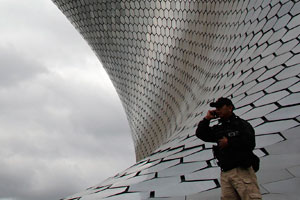
In Mexico City’s Centro Historico are the remnants of the Templo Mayor, one of the main Aztec temples of their capital Tenochtitlan. You can see six layers of the temple’s walls – the temple rebuilt six times, each time bigger to cover the last as it started to sink into the unstable earth.
The temple and its artefacts formed the centre of the excellent Aztec exhibition at Te Papa last summer. Seeing it however is something else altogether again.
The remarkable archaeological excavation that began 35 years ago, and continues today itself required the demolition of a block of grand buildings of the Spanish colonial era.
This is a space of great architectural beauty. Modern Mexico’s architecture has followed this heritage. A visit to this city is made to many outstanding buildings. That buildings might provide identity is deeply embedded here. It is how they are placed and how you experience them, which gives you an appreciation of how form operates in space.
These are things we lack in New Zealand. Much celebrated architecture in Mexico City acknowledges a rich indigenous past, while making a modernist statement of strength, independence and of being at the vanguard. Different artistic media have traditionally always been far more melded and part of public space. Buildings are spoken of as sculpture. Through the work of last century’s muralists (most famously Mexico’s Diego Rivera), painting is part of the urban fabric. It’s easy to see why the city might now accept easily contemporary artists’ interest in working across media, and making their work in its concerns more of the world.
The gods being honoured today, however, are the corporate kings. If Templo Mayor is the heart of the old centre, the Soumaya Museum – Museo Soumaya – in the Nuevo Polanco district is a stake in the ground, asserting a new centre. This astonishing building was opened in 2011 for the art collection of the world’s richest man Carlos Slim, head of, among other things, Mexican telecommunications company Telmex. It cost US$70 million (NZ$81m), boasts more than 66,000 pieces of art – mostly European works from the 15th to mid 20th century – and has had more than 2.6 million visitors.
Until recently Nuevo Polanco was warehouses and factories. Now office towers and shopping centres are mushrooming. They all gather around the glittering Soumaya, designed by Mexican architects FR-EE.
Like Frank Gehry’s buildings, its 3-D wave shape with silver scaled surface owes much to what is now possible with new materials, digital technology, and lots of money. As eye-popping in reality as in the photographs, its skin reminded me of the snakes that adorn the Templo Mayor.
Mostly, though, it simply sets out successfully like a glitter ball, in the presence of straight lines, to wow you. Inside it’s both glorious and functional. You ascend, as in Frank Lloyd Wright’s famous Guggenheim, by exterior hugging spiral, viewing Slim’s extensive art historical collection. It ranges from da Vinci and Botticelli near security check-in, to a large Rodin sculpture court at the top.
Ad Feedback
Across the road is Museo Jumex, which opened last year and is funded by Mexican Juice barons the Jumex group. Designed by David Chipperfield, the building neatly and modestly visually references the factory, the juice box and Aztec architecture, yet ultimately inside it’s as dull as a juice box .
Around these museums the signs read Costco, Cinemex, Starbucks, Nestle and Saks Fifth Avenue. An aquarium has sprung up. There is plenty of parking below the shopping centres. It’s the antithesis of what I saw of the rest of Mexico City.
At the base of Soumaya is, of all things, a rose garden. I’m reminded of a work I saw a day earlier by British artist Olivia Plender. On an embroidered banner is an image of Britannia holding an Edwardian shopping centre with the words emblazoned “Britannia Receiving Her Newest Institution”.
Plender’s work features in an excellent international group show Theatre of the World at Museo Tamayo exploring architecture’s role in political and social representation. As this exhibition bears out, architecture often represents power, and too often offers shallowness, built to make an impression of progress and prowess for a moment in time.
Alexander Apostol has photographed the impressive concrete skeletons of large hotels in Venezuela, begun during a property boom but never completed. Gardar Eide Einarsson looks at the fake North Korean “Peace Village” on the border with South Korea. Kjong-Dong looks like it houses many, when in reality the buildings are well- maintained shells, for the viewing benefit of those looking over from South Korea.
On my travels I’ve seen grand follies, remnants from world fairs and games, old statements of national prowess. I can’t think of any New Zealand examples. We don’t need great monuments and our modest low-lying Kiwi way has much to recommend it.
Our most interesting piece of museum architecture, the Adam Art Gallery in Wellington, ingeniously utilises the empty space between existing buildings. It’s dynamic yet un-monumental. Yet we need to be far better at valuing our built environment.
I’ve barely scratched the surface of Mexico City – fast being talked about as a “new Berlin” in terms of its emerging contemporary art energy. There’s a surge in artist-run spaces, pop- up enterprises and artists moving here from elsewhere. New Zealand artist Kate Newby has just arrived as I write, with a show opening at Lulu, a small space, this coming weekend.
MUST SEE
Wunderruma: New Zealand Jewellery, Dowse Art Museum, Lower Hutt, until September 28. Curated by two wunderkinds themselves, Warwick Freeman and Karl Fritsch, this exhibition of 75 interesting contemporary New Zealand jewellers and artists was first shown in Munich and promises much.
– The Dominion Post